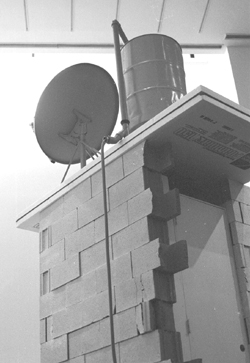

New Allen Exhibit Examines Modern Architecture
by Christina Morgan
Architecture is undoubtedly an art form created by people, for people.
The 28 works displayed in Contemporary Art from the Permanent Collection,
which opened Tuesday in Allen Memorial Art Museum’s Ellen Johnson Gallery,
are designed to explore human relationship to architecture.
 (photo by Hans Peterson) |
The exhibit highlights newly acquired
pieces from Slovenian artist Marjetica Potrc, who was this year’s winner
of the Hugo Boss Prize, established by the Guggenheim Museum in New
York City. Six of the 28 pieces on display are Potrc’s, consisting of
two sculptures and four prints.
According to AMAM’s Curator of Modern and Contemporary Art, Goran Tomcic,
Potrc is a self-described “social anthropologist” who “takes examples
from reality and brings them to exhibition space.” The exhibit’s most
notable example of how Potrc implements social issues connected with
architecture in her work, can be seen in her newly commissioned architectural
installation East Wahdat: Upgrading Program.
East Wahdat: Upgrading Program, is Potrc’s depiction of one of the many
core units, or toilet sewage systems, that were added to the shanty
towns of Amman, Jordan, that were upgraded in 1995. The piece boasts
bright colors such as yellow, red, pink and blue, and is the largest
object in the gallery. Also notable in East Wahdat, is a large satellite
dish installed on top of the core unit, which seeks to illustrate how
even those living in the poorest of conditions still want to be connected
to the world.
Contemporary Art from the Permanent Collection also chronicles “how
an artist gets caught into an idea and makes plans,” Tomcic said. The
exhibit boasts several examples of how architectural and sculptural
projects begin on paper. American artist Eva Hesse’s drawings of her
sculpture of the bodies of Trojan Priest Laocoon and his two sons trapped
in the grip of pythons, is the first of these “works in progress” seen
in the exhibit. These drawings of the sculpture, which now stands in
AMAM’s sculpture court, illustrates Hesse’s obsession with her project
both before and after its completion.
The other “works in progress” displayed were created by artists Claus
Oldenburg. The exhibit shows three drawings of his plans for his Three
Way Plug sculpture, complete with a model of the sculpture sitting below
the preliminary sketches. Of particular interest, are Oldenburg’s drawings
for Allen Memorial Art Musuem, which gives viewers a glimpse of what
Allen would look like if Oldenburg had received the commission.
In keeping with its theme of “the human relationship to architecture,”
Contemporary Art from the Permanent Collection, displays two works by
African-American artists Roy Decarava and Carrie Mae Weems, that explore
emotional connections to architecture. Decarava’s Harlem Hallways depicts
the “economics of buildings for poor people,” through a simple print
of a dark, decrepit hallway like many that Decarava passed in his youth.
Harlem Hallways, is a simplistic, yet emotionally detailed picture that
successfully emits the sentimental connection humans share with architecture.
Weems’ Grabbing Snatching Blink and You Be Gone from the series Africa,
also explores the emotional connection to architecture. Her mournful
images of abandoned slave prisons off the coast of West Africa, much
like Decarava’s Harlem Hallways, clearly reinforce the idea that there
is a human connection to architecture.
“We shelter architecture as much as it shelters us,” Tomcic said. Those
who view AMAM’s Contemporary Art from the Permanent Collection, will
clearly realize the truth in this statement.
![]()
Spring Back Fuses Funk, Ballet and Modern Dance
New Allen Exhibit Examines Modern Architecture